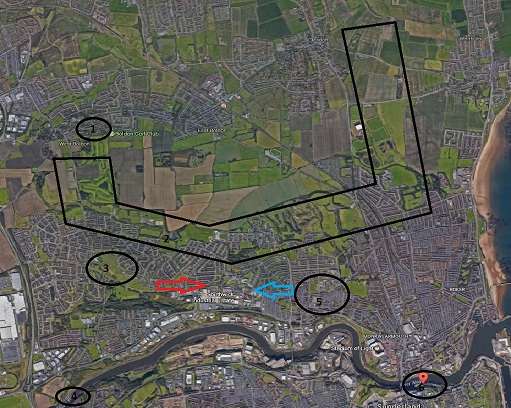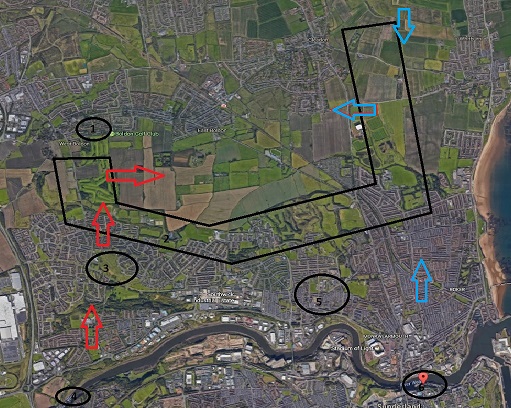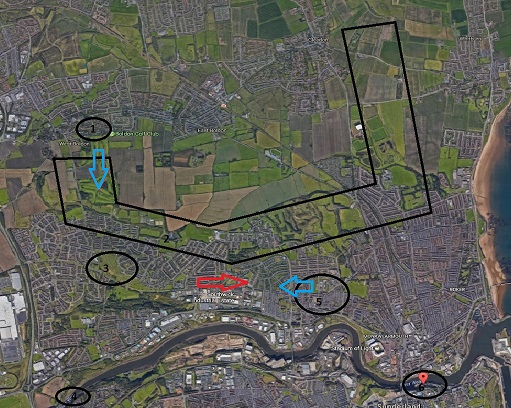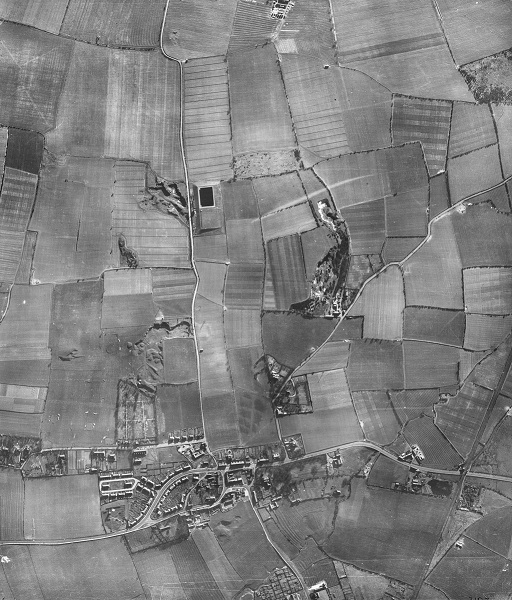

There are conflicting opinions on the location of the Battle of Boldon Hill also known as the Battle of Hylton:
Sunderland and It's Origins: Monks to Mariners by Maureen Meikle (Author), Christine Newman (Author)2007.
This book states the battle is incorrectly called the Battle of Boldon Hill and should be called the Battle of Hylton. It is claimed the battle actually took place between Boldon Hylton (3) and Southwick (5), with the fighting centred around Hylton (3) because of the stratigically important Castle and River crossing at Hylton (4).

Scottish forces came from South Shields, Sunderland (6) and from the smaller garrison at West Boldon (1) with Leven setting up camp on Southwick hill(5) in the east and other troops in the North (Boldon Hill) under the command of Robert Douglas (1).
The Royalist forces attempted an attack on Levens forces under the cover of fog on the Sunday. Douglas reported fighting began that afternoon and cannon fired until midnight, when the Royalists retired to Hylton.

The next day 25th March the Scots dug in cannon emplacments and at 2pm there was a skirmish at Boldon Windmill (1). two hours later hand to hand fighting near Boldon hill saw Royalists killed and taken prisoner. the Royalists retreated to durham.
it is then claimed the Scots crossed the river and camped at Farringdon hall. The Scots had no time to muster their cannon from Sunderland but by the help of some seaman 1 great cannon was brought across the river to the battle field.
Its is claimed that both sides taunted each other over the battlefield, open warfare was hampered by the hedges and ditches. There were many dead on both sides. The Scots claimed to have killed more Royalists than they lost lost. The Royalist claimed to have killed or captured over 1,000 Scots and only losing 240 common soldiers. The scots admiited to 300 wounded with 60 dying and claiming to have killed over 1,500 Royalist.
local records or historical register of remarkable events, John Sykes, 1833 p94-p96
According to this record 1644 Jan 15 the scots army crossed the tweed in severe winter with a force of 18,000 foot and 3,000 horse. On the 6th Leslie brought his heavy ordnance by sea to Blythsnook, then upto their camp outside of Newcastle. The Scots remained there till 22nd February without gaining any material advantage. The Scots the left Newcastle leaving six regiments of foot (6000 men) and some troops of Horse on the north side of town to observe whilst the main body of the army marched to Sunderland arriving on the 4th of March.
On the 7th of March the marquis of Newcastle with the Yorkshire Horse under Sir Charles Lucas drew up on Boldon Hills to face the Scots trying to draw them into battle until midnight but the nature of the ground which was intersected with hedges and trenches prevented each side from an open attack. On the 8th the light parties Skirmished with each other but the Scots could not be drawn from their position so the Marquis retreated to Durham intent on preventing the Scots from gaining supplies.
The Scots in Sunderland were very short of supplies so on the 13th they left Sunderland leaving a Garrison of two regiments (approx 2000 men) and went searching for supplies, they made camp between the Wear and the Tyne near South shields (most likely Cleadon with about 10,000 men). On the 15th they attacked South shields where they were repulsed. They returned again on the 20th storming the fort losing nine men in the process.

On the 23rd The Royalists left Newcastle arriving on the High grounds above Hilton with the Scots facing them all day on the heights nearer the sea, as night approached the two armies swapped cannon and musket fire which continued the next day. The Marquis was unable to draw the Scots out from there positions so he then decided to make a tactical withdrawl to Durham.
Government, Religion and Military affairs in Durham during the civil war and interregnum, Dumble, W, 1978 p86-90
This account relates that the period between the 8th and 23rd of march was mainly used by both sides to gather strength and assess the state of the enemy. The weather at this time was still very poor with different accounts stating snowy conditions. The Marquis of Newcastle would have been aware of need for supplies for the Scots army and with the fall of South shields these supplies were now starting to come through so he was eager to press for battle before the Scots could strengthen. The Scots however were still very short of Supplies for their Horse so were not eager to move from the coast and leave their soldiers on foot without the protection of horse but if the horse were to stay then they would starve.
The Royalists took up position at Hylton on the 24th with the intention of drawing the Scots into battle. The main Body of the Scottish army were quartered a mile or so North of the Wear , foraging between there and Shields and Westwards through Boldon. (this would put them around cleadon as in other accounts). The Scots were reinforced with about 3000 men from Newcastle under the caommand of Sir James Lumsden so now with an approximate force of about 13,000 foot. Again the account states the Royalists occupying Boldon Hill overlooking the village and the Scots to the East towards the Sea.
As in other accounts the two sides engaged in skirmishes and swapped musket and cannon fire hampered by the terrain until the Royalists having gained no advantage retreated to durham in need of reinforcement.
https://en.wikipedia.org/wiki/Battle_of_Boldon_Hill
Claim the battle took place in the fields between Boldon and Cleadon. The premiss for this was the Scots on the 20th had attacked the Royalists at South Shields. after the battle Levens army were camped on the hills where Cleadon Windmill and Water Tower are located. The Royalist army came along the river from the direction of Newcastle and setup camp on the top of Boldon hill opposite from Cleadon hills. The Royalists attempted a sneak attack on the 24th the Sunday as in the other version, Skirmishes then took place in the fields in between both sides which would effectively have been the fields of West and East boldon. With the ground in between full of ditches and hedge rows, open fighting was not possible. the Maquis of Newcastle then decided to make a tactical withdrawl to Durham leaving a rearguard action.
My thoughts
Being a local lad I have the benefit of knowing some of the terrain. The problem I have with the 1st account is that it is very muddled.
It is stating that Royalist forces were at Hylton whilst the scots were at Southwick and Boldon. This would immediately put the Royalists forces at a disadvantage as they would be in the middle of two forces with scots holding the higher ground at Boldon. Also it should be noted that the ridge of higher ground (indicated by the polygon) runs approximately parallel to the river from Hylton to Southwick being quite steep in places, I have heard of several battles being fought up and down a hill but never along the side of one? so again unlikely.

It is suggesting then that the Royalists attacked the Scots in the east at Southwick yet the Scots behind them in the West did nothing when they could have easily attacked them from the rear and of course could have taken control of the Castle (3) and the crossing at Hylton (4).
It is also worth noting that although Hylton is a castle in name, it is actually a fortfied house. unlike normal castles it had lower ground windows, no moat, no outer defensive walls and is actually located halfway down the side of a hill and not as usual ontop of a hill. The importance of the last point is that even a small force of a dozen riflemen placed ontop of Bunnyhill (3) could shoot down into the castle from the higher advantage point. This seems to be born out by the fact that little war damage to the castle has ever been evidenced. Also it was common practice by the Parlimentary forces to destroy any castle fortifications that they did not intend to occupy incase they were a threat in the future. This castle as we know was left untouched.
Another point of note in the 1st account is that the Royalists retreated to Durham and then the Scots crossed the river and camped at Farringdon. It then says they tried to bring cannon across the river from Sunderland. Farringdon is of course already on the same side of the river as Sunderland so this would not have been needed.
The next bit stated that the opposing forces taunted each other after that, across the battle field and skirmishes and hand to hand fighting took place around Boldon mill, this again is a puzzle as the account states the Royalists were in Durham and the Scots were at Farringdon both of which are on the wrong side of the river so the battlefield would have to be to the south west of Sunderland well away from Boldon and Hylton.
In my opinion the second account is the most realistic without definitive evidence. We know the Scots were based in Sunderland (6) and if they were to attack South shields, they would do so by approaching it along the coast which they had control of (accounts state the Navy was blockading the port of Tyne). In doing so they would travel through Cleadon and as this is the highest point on route it would be the optimum place to camp and forage for food as stated by W. Dumble in his thesis.
The Marquis of Newcastle with the Royalist forces as we know moved toward Hylton, it would be madness then not to occupy the high ground at Boldon hill which is only about a mile from Hylton castle as this would give them the strategic advantage.
It would then be logical that any small garrison based at West Boldon (1) would have retreated and joined forces with the main body on Cleadon hills. The attack by the Royalists could have then taken place from Boldon towards cleadon, the cannon then brought across the river from Sunderland at Pans bank (6) to reinforce the Scots at Cleadon. As before the skirmishes taking place across East and West Boldon until the Royalists retreated to Durham with the Scots following on later.
It is also interesting to note that from the first two accounts it appears there was more than one Battle/Skirmish between the Marquis of Newcastle and the Scots forces around the Boldon area. The 1st skirmish being on the 8th suggesting the Marquis had just a force of Horse, which was not uncommon at the time for both sides to send out Horse to Harry the enemy. This was an attack on maybe a small garrison at Boldon there to gather food and supplies with the intention of drawing out the scots main forces from Sunderland. Having failed to draw the Scots out then the slightly bigger engagement occuring on the 24th/25th this time the Marquis having foot and artilliary.
I have little definitive evidence to support this as yet but there have been some instances of possible circumstantial evidence. On my main English Civil War Page is a Photograph of a Cannon ball found at Cleadon Hills.
Further to this in 1898 a newspaper reported when works were being carried out digging the resevoir at the top of Boldon Hill (center of picture) Skeletons were found with the article stating "thought to be from some battle". Another newspaper report from 1899 found skeletons at west Boldon House (behind the Red lion, to right of village near bottom of picture), state that they may be quaker burials, known to have occurred there but the interesting part was the statement "thought to be over 200 years old" this would put them near the time of the supposed battle. Another News report in the 1950's stated the possible english civil war skeletons found whilst building a new housing estate in the 1950s, with the possible location being the Hardie drive (1) area which was built at this time. (to the left of the village near the bottom of the picture below Boldon Windmill).
The aerial photograph below (Reproduced by permission of Historic England Archive) from February 1946.
